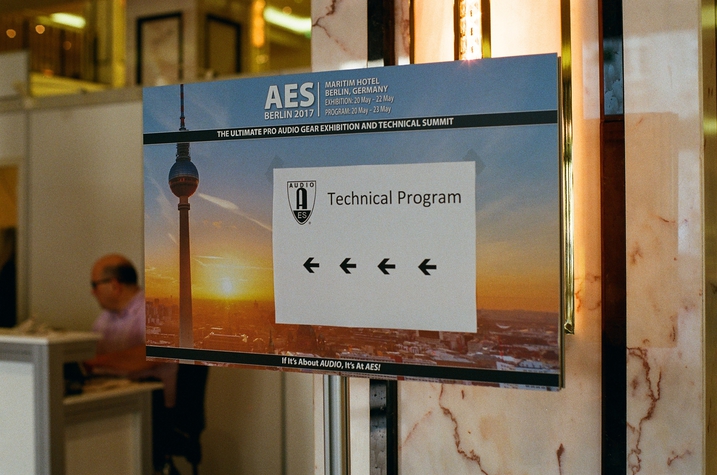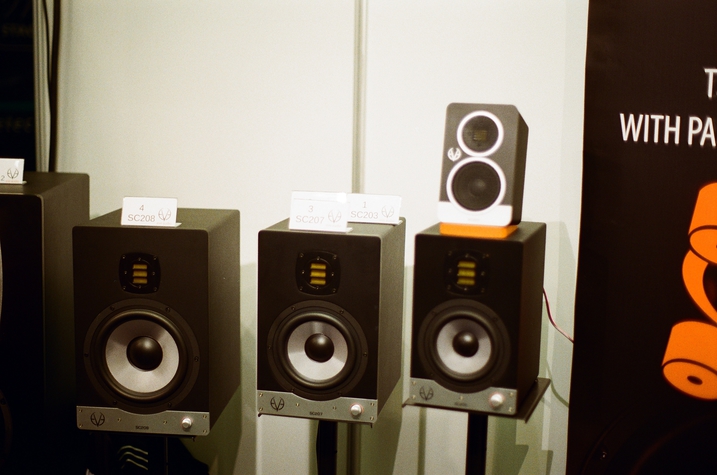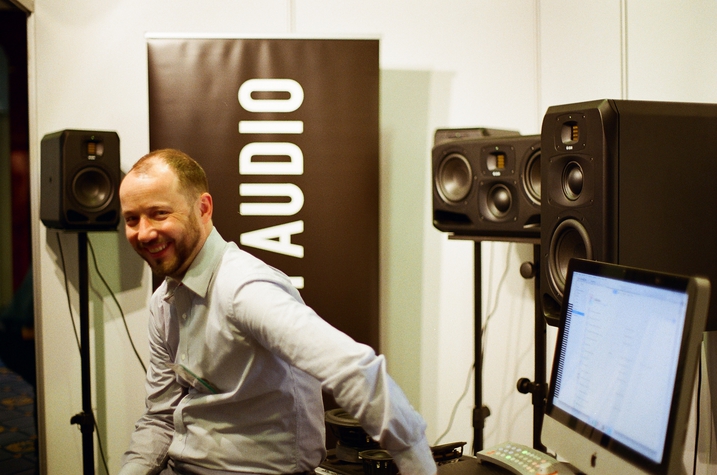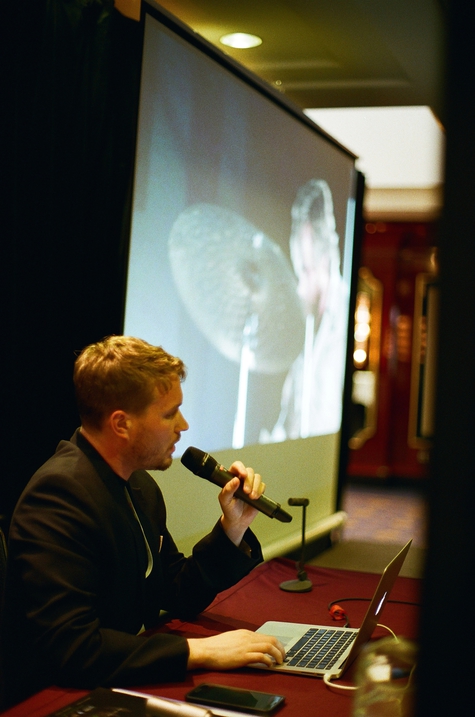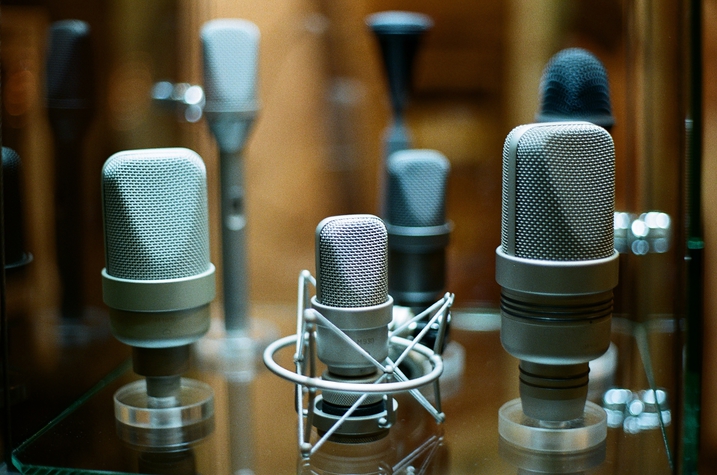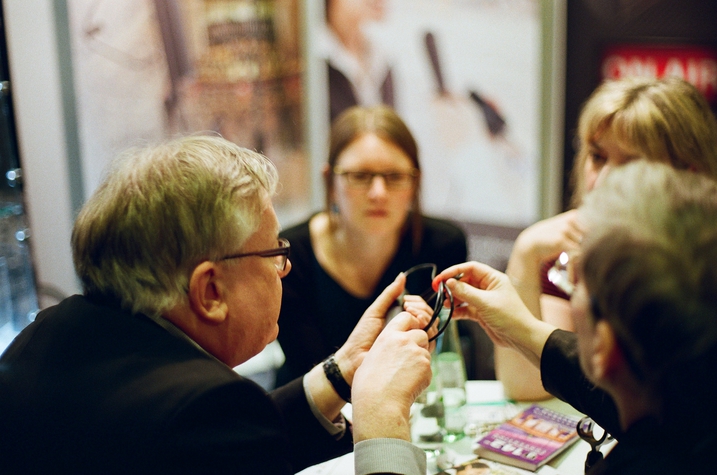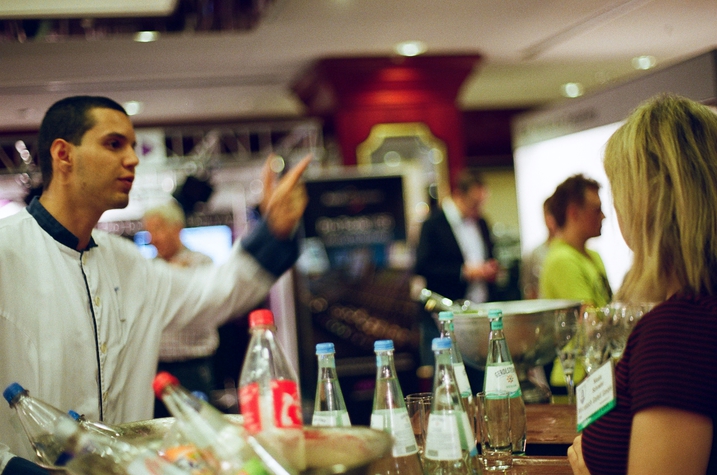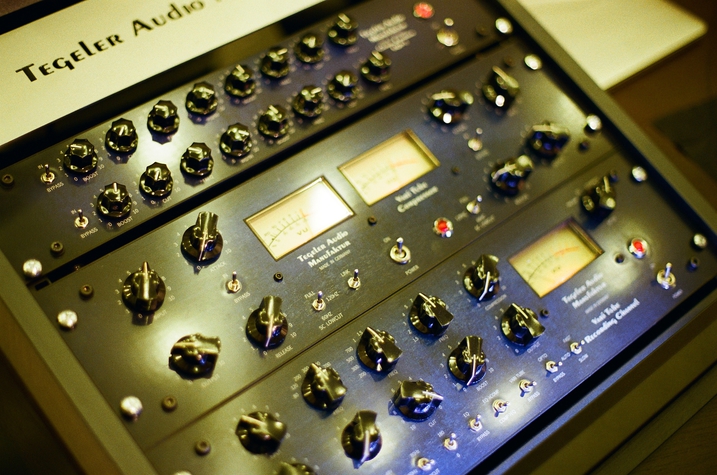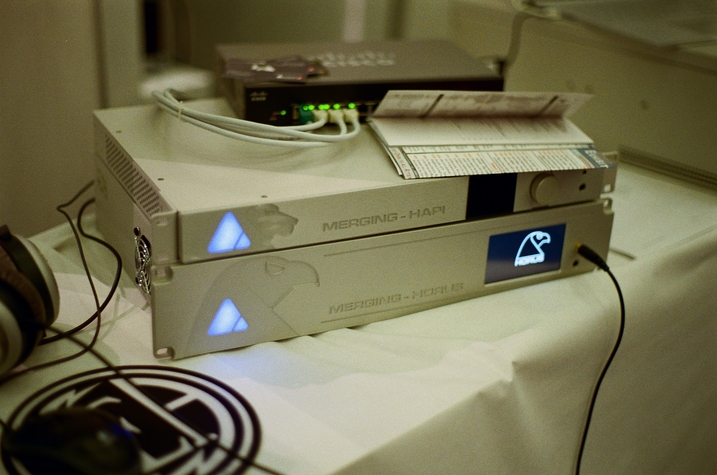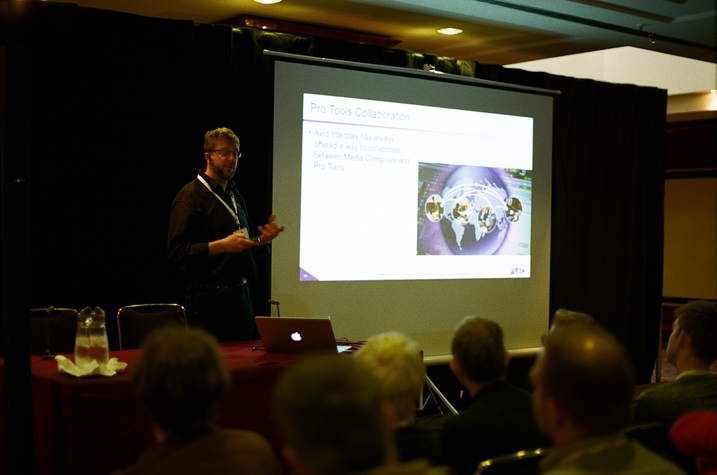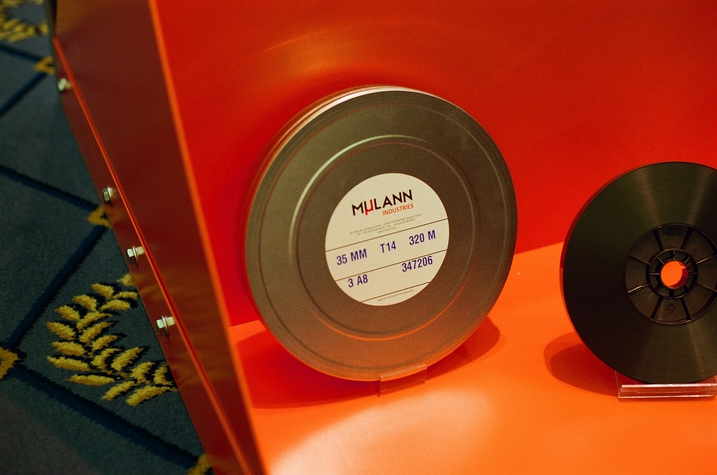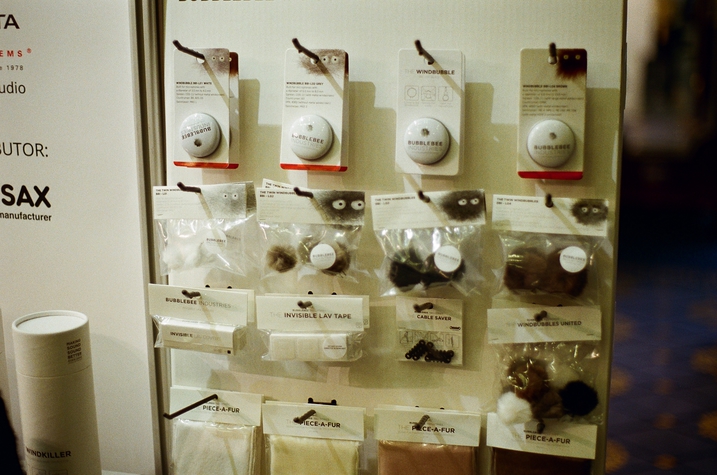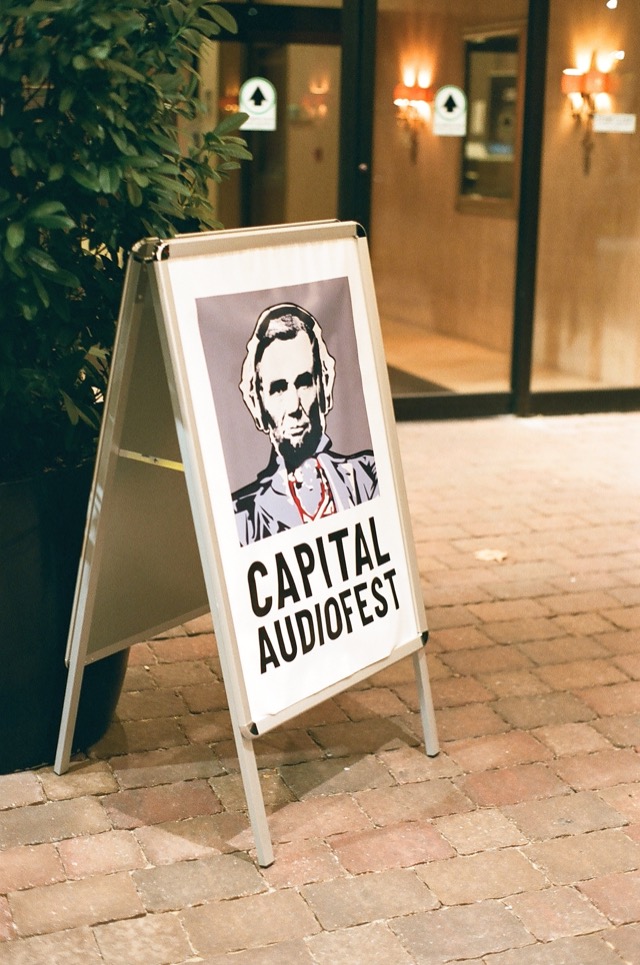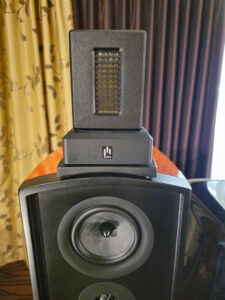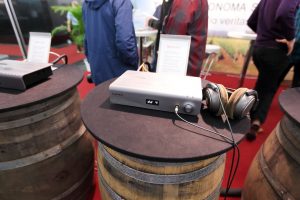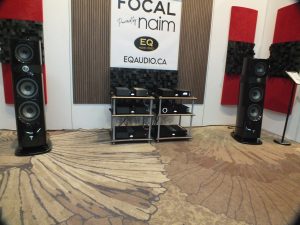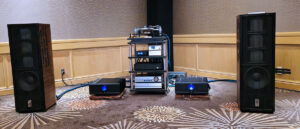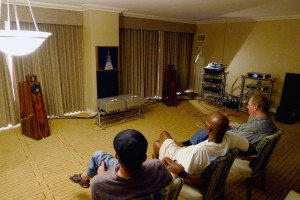The Audio Engineering Shows in Europe are much smaller and more oriented toward papers than the trade show, which makes them a good opportunity to sit and talk with people actually doing real audio research. This year AES 2017 Berlin was no exception. The conference was held in a hotel on the former East German side, which was an absolute blessing since the hotel had features like heavy sound isolation between conference rooms and a raised stage in the main ballroom which you no longer see in western hotels. The facilities were by far the best I have seen for this show, and the presentations were no less excellent.
Speakers
There was really very little discussion of sound reinforcement at this show. There were a few papers on sound reinforcement systems and speakers but for the most part it was all audio production. That being the case, there were a large number of monitor speaker vendors at the show.
What I thought was most interesting was a new company, HEDD, which was founded by speaker designer Klaus Heinz and his son. They are making a new driver based on the original Heil AMT, but smoother and cleaner than both the original Heil driver and the similar drivers used by a couple other studio monitors today. HEDD is currently making only some powered speakers with internal amplifiers but they are looking at getting into the high end home market with some passive boxes. What I heard of their speakers was very good, with the ability to give a competent image even under very bad show floor conditions. There was a tech tour out to the manufacturing plant nearby in Berlin but sadly I missed it.
EVE Studio Monitors
I believe that Dr. Heinz originally designed the AMT drivers for Eve Audio in Berlin, and they also were at the show with a wide range of very clean sounding from small minimonitors on up to large mastering speakers designed for film dubbing stages. These are also well worth checking out if you are interested in any manner of speakers using that style tweeter.
ADAM Audio Speakers
Similar high frequency drivers are being used by ADAM for their line of monitors, which again are a German product with a longstanding reputation for quality. It seems like there are a lot of newer German speakers using this technology, and I wish the show had good enough listening conditions that I would have been able to compare them.
PMC Speakers was showing off some other excellent sounding mastering monitors, and I got to listen to the IB1S-AIII, which again is powered with internal amplifiers although PMC also makes some excellent passive speakers as well. The PMC speakers have very clean and extended low and and a dry and analytic sound to them that is both marvellous in the mastering room but would be at home in any good listening room.
Neumann was showing off their line of mastering speakers, which are follow-ons to the Klein and Hummel line which they took over many years ago. These are again designed for mastering work with an accurate and clean midrange and open and detailed but not spitty top end. But what was most interesting at this show is that Neumann was handing out a free booklet called "Setting Up Studio Monitors" which I highly, highly recommend to anyone setting up loudspeakers anywhere. It is a fine introduction to the basics of speaker setup and speaker-room interaction, with discussion of a lot of placement issues which are all too often ignored in the high end world. It is worth looking up this booklet no matter whose speakers you are using.
PSI Audio from Switzerland was also there, showing off their line of smaller monitor speakers. These folks make both active and passive speakers, and everything that I have heard from them over the years has had a very deep and detailed image. Controlled, if a bit restricted low end, but very wide and deep imaging seems to be their hallmark. They make everything from some inexpensive broadcast monitoring speakers on up to some very expensive but very accurate mastering monitors.
Genelec was showing off their new line of three coaxial monitor speakers, and Aki Makivirta from that company gave a talk "The Acoustic Design of Minimum Diffraction Coaxial Loudspeakers with Integrated Waveguides" which was a good introduction to the history and basic physics of the coaxial speaker design. Preprint 9695.
Another Finnish company, Amphion, was showing a range of monitors based around titanium dome tweeters with a shallow waveguide and aluminum cone woofers. I wished I had a chance to hear these under better listening conditions because they looked promising.
I'd just like to say that this is the first AES show where I have not heard any speakers that just plain sounded bad. Every speaker system I heard was of a standard that I'd be willing to have it in my home, even if the demos were not always the best conducted and the room setup was invariably poor. In spite of that, there were still some papers about making speakers that weren't necessarily intended to sound good. If you make a speaker in a fairly narrowband enclosure, it can be very efficient over a narrow frequency range but require a good bit more power for wideband response. In "Efficiency Investigation fo Subwoofer Driven Around Resonance Frequency," Tobias Thydal, and two others from the Technical University of Denmark used dsp to replace wideband bass with a narrower range of frequencies around the speaker point of resonance. They did, not surprisingly, find a considerable improvement in efficiency which might be of benefit on systems powered by batteries. However, they didn't mention the severe degradation in sound quality that one would expect to be caused by such processing. Preprint 9698.
However, specifically looking at audible speaker artifacts was Juha Backman from Genelec, with "Nonlinearity of ported loudspeaker enclosures." He has constructed a computational fluid dynamic model of a ported loudspeaker with air compressability modeled, and he sees nonlinearity issues in higher pressure regions near loudspeaker ports and waveguides. Such effects have been known before but this is likely the first time they have been succinctly and clearly quantified. Preprint 9697.
Not many driver manufacturers this year, though. Peerless was there and had their line of very well-designed speakers for monitors and high end home gear, but they were the only ones.
Headphones
One of the serious problems with earphones and headphones, especially closed back ones, is that they are employing the ear canal as a sealed resonant system and so the shape and volume of the ear canal affects the frequency response of the headphones. A method of setting up headphones with measurement hardware to self-calibrate against the structure of the ear was demonstrated by Juha Backman and Tom Cambpell of Hefio, in "A Self-Calibrating Earphone." Engineering Brief 347.
Down on the show floor, Hefio was showing off this system as the Hefio Play and we were able to actually audition them. The concept is a very good one.
Microphones
Microtech Gefell Display
A number of the old line microphone vendors were there, including Neumann and Microtech Gefell (which is the old Neumann factory that was cut off by the building of the Berlin Wall). Josephson Engineering was there.
Sennheiser was showing off a thing called "Ambeo" which appears to actually be three unrelated 3-D imaging recording processes for speakers, headphones, and virtual reality systems, but all three of them interesting with attempts to replicate image height as well as width.
In "Ambience recording for 3D audio," Marco Hanelt and Andreas Ehret from Dolby talked about various configurations of microphone arrays for recording ambient sound fields for multichannel film playback systems that included height channels, and came up with a guide to best practices under various different conditions. Engineering Brief 312.
On the trade show floor was a series of rather short presentations from vendors under the name of "Professional Sound Expo Sessions." I went to a couple of these, and one of the ones I went to about microphones was just painfully bad. I won't mention the poor presenter, but he repeated a lot of generalizations that perhaps once were good assumptions to make but no longer necessarily are. It was an example of the exact sort of thing that I frequently complain about in the industry: information that is on the surface a useful rule of thumb, but which obscures what is really going on under the cover and which eventually will trip you up if you don't understand that.
On the other hand, this was more than made up for by Martin Schneider's talk "U87 Microphone Development in the 1960s" where he went through the complete evolution of the U87 over the course of fifty years. A great talk about how the design changed with alterations in production facilities and limitations. Engineering Brief 321.
Another presentation that was worthwhile was "Do microphone angles result in audible difference when recording a guitar amplifier?" by Ellen Culloo and Malachy Roonan from the University of Limerick. They found that with conventional dynamic microphones like the SM-57 or the Royer R-101 ribbon that the tone of a guitar amplifier was affected by the point along the cone where the microphone was placed but not much affected by the angle the microphone was pointed. This makes sense given the positioning of the microphone in the near field of the source but it's an interesting rebuttal to a common misconception in the industry. Engineering Brief 313.
One of the things about microphone patterns is they vary tremendously with frequency. Two microphones sold as "cardioid" may have totally different patterns at midrange frequencies and both almost certainly will be omnidirectional at 50 Hz. The plots on the datasheet only tell a tiny part of the story. In "Interactive Display of Microphone Polarity Patterns with non-fixed Frequency Point," Johnathan Ziegler, Hendrik Paukert, and Bernfried Runow demonstrate an ingenious interactive computer display that shows this and how it changes with frequency. This is a useful tool both for engineers and educators. Preprint 9793.
At the Gefell Booth
Concert Acoustics
An increasing number of ancient theatres are being put into use for actual performances today. It's not all just Yanni Live at the Acropolis either, but there is interest in classical concerts in such places. Unfortunately the sound quality in these theatres is poor for a number of reasons, including sections of the original structures being missing and because of the increased absorption as the audience comes in. In "The audience effect on the acoustics of ancient theatres in modern user," Giano Iannace and Amelia Trematerra create a computer model from acoustical measurements of several ancient auditoria and show a dramatic drop in low frequency reverb time due to the audience, often taking it lower than half a second which can be quite problematic for acoustic music. Preprint 9702.
In "Investigating the impact of a music stand on stage using spatial impulse responses," Sebastia Vicenc, Amengual Gari and Malte Kob set up a directional loudspeaker with the approximate radiation pattern of a trumpet and a microphone array, then placed a music stand in front in order to simulate the effect of such a stand in front of a brass player. Significant comb filtering from reflections off the stand changed the timbre of the instrument at the performer's position. Again, this is an effect that a lot of people have noticed but here is a good attempt at quantifying it, and this may lead to some hints for reducing the issues. Preprint 9746.
Listening
Perceptual encoding systems for lossy compression of speech are often tested using standardized word lists to calculate intelligibility. How effective is this when the listeners do not speak the language of the word lists. In "Is it Harder to Perceive Coding Artifact In Foreign Language Items?" a mixture of authors from Germany and China find that although there may be a need to slow the presentation down for non-native speakers there is surprisingly no difference in overall results. Preprint 9739.
Since perceptual encoding systems designed for speech are designed to pass only the minimal speech characteristics needed for intelligibility and filter everything else out, David Dittner and Edger Behrdal got the notion that they could also be used for feedback suppression. In "Using a Speech Codec to Suppress Howling in Public Address Systems" they do just that, and get remarkably good results although only when reducing the codec quality substantially. My first thought about this was that it was a horrible misuse of an encoding system but as the talk went on, I thought more and more about it being kind of an ingenious trick that might be a useful improvisation in the field some time. Preprint 9800.
How important is imaging in the overall scope of sound quality? Russell Mason at the University of Surry, in "How important is accurate localization in reproduced sound?" asked a number of people to list sound quality attributes and the majority of the ones listed were localization-related. Does this mean the localization is actually more important than tonality? Or does it mean that people have an inflated notion of the importance of localization? Or does it mean that localization improvement is the first thing people notice when they hear improved reproduction? This is a paper that answers one question which causes a whole other list of new questions to be answered. Preprint 9759.
Paging systems used for life and safety applications such as fire alarm announcements in the United Kingdom require in-use monitoring and testing to make sure they are functioning in the event of an emergency. It is common to use a constant tone around 20 KHz for test purposes, but some people can hear the high frequency leakage that results. To what extent is this audible? To what extent do voice-grade speakers even manage to reproduce 20 KHz? How is the resulting tone radiated? Peter Mapp begins to tackle these questions in "Potential Audibility and Effects of Ultrasonic Surveillance Monitoring of PA and Life Safety Sound Systems," preprint 9776.
Taking ultrasonic perception from the other direction, in "Discussion on subjective characteristics of high resolution audio," Mitsunori Mizumachi and others did listening tests between 192/24, 48/24 and 48/16 PCM audio in both a car and home environment. Differences between the bit depth were not readily discriminated at all but there were clear differences in discrimination between sample rates even when there were not between word lengths. However, the test was conducted with no actual testing of the ultrasonic content of the signal or any testing for fold back of ultrasonic sounds into the audible range, so it is difficult to tell why this result happened. It might be due to ultrasonic perception, but it might be an artifact of the playback. And, of course, just because something sounds different does not mean it is necessarily any more accurate. This was the beginning of a good study but far more needs to be done by the authors before this can be credited as useful. Engineering Brief 315.
Large open-air events have issues with sound spilling into adjacent communities and consequent noise complaints. Methods used for determining community noise levels generally assume incoherent sound sources like highways (which consist of many moving uncorrelated sound sources) rather than one coherent source. Methods used for determining sound levels in concert halls often don't scale well into the very far field. Matthias Christner, and others from d&b audiotechnik and SoundPlan International came up with a reasonable model and wrote software called NoizCalc for implementing it. In "Far-field noise prediction for open-air events. Part 1: Background and propagation models," preprint 9790, they describe the algorithm and process. In "Part 2: Experiences and Validation" they compare the results of the model with actual measurements and show it works well. Preprint 9791.
Mit Gaz, Danke
Mixing Tools
A French company, HarmonicSculptor, was showing off an all-analogue device which they claim can control the distribution of harmonics in an audio signal without introducing any new harmonics. Doing this would be the sort of thing worthy of a Nobel prize because it would require a pretty dramatic revolution in signal processing theory, so I am a little bit skeptical about the device. Well, actually a lot skeptical. But if it does do what they it would be the most exciting thing in years.
DSpecialists from Berlin were showing the Isostem device, an upmixing unit intended for broadcast applications that silently converts stereo mixes into surround signals. They didn't have any way of auditioning the unit, and I have been suspicious of the whole idea of upmixing ever since the era of LPs "electronically rechanneled for stereo playback" but it may be worth some investigation.
Tiegler
Tiegler Audio Manufaktur in Berlin was showing off a multi-band tube compressor that looked quite interesting and well-constructed. This is typical of the small European companies making high quality gear that never get seen in the US market. They actually have a large line of tube audio processing products and companies like this is the reason why I like going to the European show.
Another German company called Zahl was showing their IM1 "insert master" unit. This is a device that fits into a two slot API 500-Series rack that allows routing and mixing of a stereo input signal through an external processor either as L and R signals or as M-S sum and difference signals. This is both a very handy tool to have if you are constructing a console out of 500-series modules (as many people today do) or if you are recording with a digital workstation and not using a full-size console. It is a convenient way to get many of the features of big console routing in a small package.
If on the other hand you'd rather do your mixing digitally, Lawo was showing off a line of digital mixing consoles for the broadcast production market. Lawo is an old German concern that has been making consoles for many years and was one of the first in the nineties to have successfully made the jump into the digital mixing world.
Pyramix Hardware
Another digital mixing and recording system, the Pyramix from Merging Technologies was also at the show, as was their Hapi digital interface and Luxor media server. This is more of a DAW system, but it's a DAW system intended for sound quality rather than flashy stuff. And it's the only DAW system supporting DSD mastering.
Digital Signal Processing
The paper "Source Separation in Action: De-mixing the Beatles at the Hollywood Bowl" by James Clarke at Abbey Road had a slightly misleading title. Mr. Clarke employed neural network methods being developed for blind source separation and de-mixing, but he used them in an attempt to separate out the audience noise from a Beatles recording that was awash in it. The method is interesting and employs non-negative matrix factorization models. Engineering Brief 307.
Modelling an analogue device in the digital world often involves first creating a continuous model of a linear analogue system as a set of differential equations and then finding a way to calculate the state out in discrete steps in the digital world. This is easy to do if you have a lot of time, or it's very hard to do if you don't. In "Joint parameter optimization of differentiated discretization schemes for audio circuits," Francois Germain and Kurt James Werner demonstrated a new method that allows a fairly simple discrete model to be optimized to match the frequency response of the original continuous model. Preprint 9751.
Felix Eichas, Etienne Gerat, and Udo Zolzer from the Helmut Schmidt University in Hamburg took a different approach. They had a generalized model, then took measurements of a physical compressor and dynamically tweaked the model parameters to match the behaviour of the real-world system. In "Virtual Analog Modeling of Dynamic Range Compression Systems" they describe the method. Preprint 9752.
Magdalena Piotrowska, Szymon Piotrowski, and Bozena Kostek talked about "A Studio on Audio Signal Processed by Instant Mastering Services." They found a number of web sites that offer to automatically master your audio under computer control. You just upload a file and they process it. They tested these services out, and it was interesting what they encountered. All the services made music louder and brighter. In every case resubmitting files already processed by the service caused them to be changed in a second pass, implying that the algorithm is not trying to match the audio to a particular pattern and processing it appropriately to hit that target, but is applying standardized processing on everything. All of the services seemed to process slightly differently but they all seemed to employ a once-through process rather than a change-until-you-hit-target process. It was very interesting to watch these people attempting to reverse-engineer the automatic mastering systems. Preprint 9719. You know, even though we aren't giving awards this year, I'd probably give this best paper in show if we were.
Class D Amplification
You can think of class D amplifiers as sort of like switching power supplies that are modulated by an audio signal to produce a varying voltage. Tracking that audio signal accurately means the waveform of the switcher needs to be far more accurate than just for a static DC power supply, and in "GaN FETs Drive Fidelity and Efficiency in Class-D Audio Amplifiers," Steven Collino and Skip Taylor talked about the advantages of a new generation of switching transistor using gallium nitride which is optimized for higher switching rates and faster rise times. As Class D amplifiers continue to take over the industry making them sound as good as the best conventional linear designs is paramount. Preprint 9735.
Components
In "The influence of the passive electronic components quality on the electroacoustic parameters of the audio devices," Maciej Sabiniok measures a number of identical circuits built with components of different tolerance and sees different performance in them. Unfortunately the components also vary in more than tolerance, with film capacitors being used in some and tantalum capacitors being used in others for instance. This introduces changes in behaviour that swamp any caused by the component tolerances. The author fails to identify what "quality" is as well, since the parameters that we would judge quality of a resistor in one part of a circuit may be totally different than the parameters we would judge the same value resistor located elsewhere in a circuit. Tolerance in an emitter resistor may be critical while that of a leak resistor may not be important at all. This was an interesting idea and a good project for students but seems to have gone wrong somewhere. Engineering Brief 342.
Kanako Takemoto talked about "Supply Voltage Scaling Technique of Triode Tube based on Harmonic Distortion Characteristics." She described the sound of mild asymmetric tube clipping as "crunch" and of heavier and more symmetric clipping as "overdrive" and she talked about the "crunch" having higher second harmonic distortion but didn't mention that this was due to the asymmetry. She showed that even with the B+ voltage on the tube reduced, the same second-harmonic-dominant distortion could be obtained. Which, to be honest is something that you could tell by looking at the load lines on the datasheet although it was interesting to see actual spectrum plots generated. Preprint 9733.
Tape
Mulann Magfilm
Back in the eighties, Agfa shut down their tape manufacturing operation to BASF. In 2007, BASF shut down their tape manufacturing, and sold the original Agfa formulations as well as many others to RMGI in the Netherlands. A couple years ago, RMGI ran into some problems and sold the formulations to Pyral in France, and Pyral apparently ran into some financial issues expanding their facilities to make the Agfa/BASF tapes and got bought out by Mulann.
Mulann is now selling both magfilm and audio mastering tape under the name "Recording the Masters" which is kind of silly and a bit of a mouthful but it still seems to be good tape.
In addition, Fred Van der Linden from AM Belgium was there. This was originally the European branch of Applied Magnetics Corp, and they continued manufacturing magnetic heads after AMC shut down in the US. They still make and sell a wide line of heads for Studer tape machines as well as some custom designs.
Film Sound
There were a couple of dealers there selling to the film sound community and selling a wide variety of different lines of products. One was showing the Sonosax SX-ST8/R, a tiny handheld 8-track recorder with balanced analogue inputs and proper microphone preamps. It's amazing to see what can be shoehorned into such a tiny space. The same dealer was also showing off a number of Nagra digital recorders, also machines known for excellent sound quality and field reliability.
Zoom was showing off some lower end film sound recorders, again good quality although a bit less solid-feeling. They had the F8 recorder, putting eight channels into a small and light box.
Gadgets from Bubblebee
Also in the film sound range, Bubblebee was showing off some fur specifically designed for acoustical transparency for making windscreens for lavalier mikes, and some very handy stick-on gadgets for attaching lav mikes to skin more conveniently than the common bandaids or athletic tape methods. Good stuff and great time savers.
Press
I got a chance to talk with a number of people from the European press at the show. Joao Martins from AudioXPress was there, just checking the show out, as was Jan Fleischmann from the German music and technology magazine, Techmagazin. Folks were there from the British magazine Resolution as well, perhaps the last magazine out there still making actual measurements in reviews.
Missing
Hassan Abbas Shakir was scheduled to give a talk on Intellectual Property Rights in Audio Engineering, which was one of the things I was really looking forward to this year because the European take on this issue is rather different than the American one. Unfortunately he did not show up and the talk was cancelled.
Tour
As mentioned earlier, there was a formal tour of the HEDD speaker plant, as well as a museum tour and a number of studio tours. I didn't do any of these things. Instead, I took a day off and went down to the Funkerberg broadcast museum in Koenigs Wusterhausen, several miles outside of the city on the light rail.
This was the site of the first music broadcast in Germany in 1920, and they have an IEEE plaque saying so, of which they are justifiably proud. They still have one of the 1000 horsepower diesel generators and a 1920s Lorenz transmitter which are complete (and the diesel is operational). The facility is beautifully preserved and their display of broadcast equipment is heavily oriented toward the transmitter rather than the studio side but is absolutely worth seeing. They went very very far out of their way to make us feel at home there and to find someone with good English skills to assist us. The exhibits do talk mostly about the prewar operation and they don't want to talk so much about the facility as a propaganda station during the war and in East Germany after the war, which is a shame since this is an important piece of history that will soon be lost if it's not preserved soon.
Summary
This was a great show with a lot of people talking about fundamental audio work. There wasn't a lot of equipment on display but was on display was the best quality stuff, with the semi-pro manufacturers staying home. You'll be seeing some of the research presented here coming out at your local hi-fi store in a few years.




